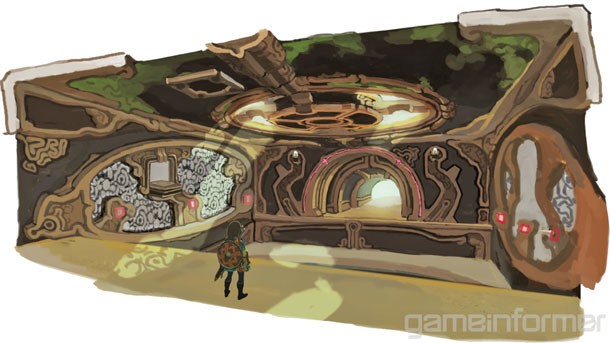Everything We Know About The Legend Of Zelda: Breath Of The Wild’s Dungeons

Pictured: concept art for the dungeon we played.
One of the highlights of our time with The Legend of Zelda: Breath of the Wild for our cover story was the opportunity to play through one of the game’s dungeons. The world is full of more than 100 shrines, which Nintendo has shown in detail during many of its Treehouse live streams, but those are different than dungeons. The shrines are small, offering a few puzzles, usually in one large room. The dungeon we played is more in line with what we have come to expect from a traditional Zelda dungeon – a large area with a series of interconnected rooms and puzzles followed by a boss.

A shrine entrance, seen from the outside.
Below, you will find some of our discoveries from our time in the dungeon, whose location in the world and surrounding story remains a mystery. It’s not guaranteed that all of these elements will appear in all of the game’s dungeons, but these are some of the elements and mechanics we saw when we played.
The map is different
Dungeon maps in the Legend of Zelda haven’t changed much over the years. You swap between floors, locked doors are identified, and you can usually see where the boss is located early in your exploration. In Breath of the Wild, the dungeon map appeared as a 3D model. Specific locations you need to pursue are marked, but we couldn’t see the floor-by-floor layout we’ve come to expect.
There is no compass
The compass, an item that shows assorted chests and secrets in a dungeon, was nowhere to be found. We asked Zelda series producer Eiji Aonuma about this and he said, “Dungeons have always been like mazes, so we needed that compass to let the user know where the bosses were placed. But then, as you probably saw, you can kind of see the goal right away. You won’t get lost – you just have to figure out how to get there.” Aonuma’s quote ties into another aspect, which is that…

Link uses the Sheikah Slate to activate a Sheikah Tower in the open Hyrule.
The dungeons are smaller and less labyrinthine
As a point of comparison, I have been playing The Legend of Zelda: Twilight Princess HD, which has some of the largest dungeons in the series. The dungeon I played in Breath of the Wild was smaller overall. That’s not to say it was shallow or easy – there were just fewer avenues for getting lost.
You may not be alone
Nintendo would not tell us whose voice we were hearing, but there was definitely a friendly voice guiding us through the dungeon. He offered general hints and told us to be careful of the boss. We never heard his voice outside of the dungeon, however, so it does not seem to be a consistent companion.
You won't find a singular, dungeon-focused item
In the past, dungeons have typically been designed around a singular item. Doors block your progress until you find, say, the hookshot. In our playthrough of Breath of the Wild, we did not find any new items. I had everything I needed to complete the dungeon when I walked in. Which leads us to another point…
The boss won't be based around a singular dungeon-focused item
Since we didn’t find an item specific to that dungeon, we only had the weapons we came in with to use against the boss.

An example of a Shrine, which has a noticeably different color aesthetic from the dungeon.
You need to prepare
While fighting the dungeon’s boss, I ran out of arrows. I was still able to defeat it using a combination of bombs and my sword, but it made one thing clear – when you find a dungeon, you need to make sure you have everything you need, and lots of it, before going inside.
Malice
This is an aspect that might not be in every dungeon, but throughout the one we played were pockets of a poisonous, sentient liquid that hurt to touch. This substance was called malice. Little eyeballs would sprout from these patches of malice, but attacking the eyeball would clear away the malice and sometimes constituted a small puzzle.
Crystal switches
The diamond-shaped switches that can be activated with an attack were present in our dungeon. Similar to past titles, they responded to sword swipes, arrows, and bombs.
Link had some control over the dungeon
This falls in line with malice, in the sense that we don’t know if it will be an aspect of every dungeon, but after activating a switch with his Sheikah Slate, Link was able to control the dungeon slightly. When looking at the map, he could tilt the dungeon in order to open new paths or to make blocks and switches slide around.
For all of our The Legend of Zelda: Breath of the Wild coverage this month, click the banner below.

Get the Game Informer Print Edition!
Explore your favorite games in premium print format, delivered to your door.
- 10 issues per year
- Only $4.80 per issue
- Full digital magazine archive access
- Since 1991










